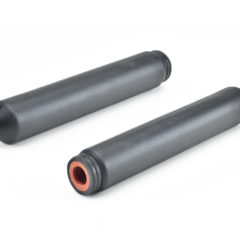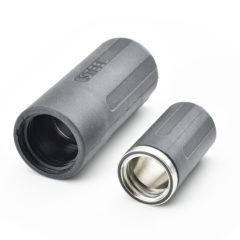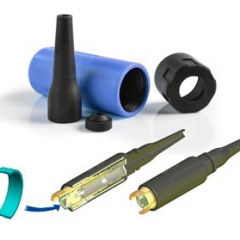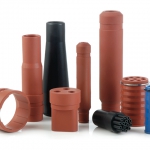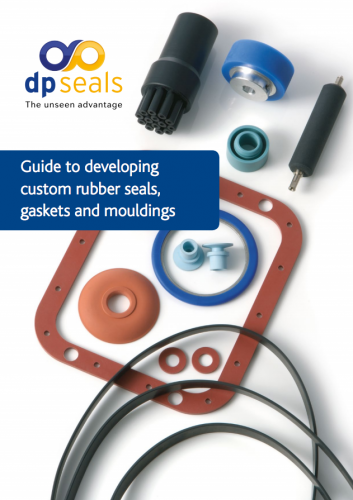Rubber to rubber bonding, often referred to as overmoulding, is a process that enables different rubber materials to be moulded together to provide characteristics that no one polymer on its own can deliver.
Some of the other benefits include:
- Producing a single part made up of different materials without the need for assembly or complicated processes
- Increasing the strength and durability of parts.
- To enhance electrical and chemical performance
- Speeding the time to market
- Reducing costs through simplifying assembly line time
- Engineering parts for highly advanced and technical applications.
Applications
Overmoulding is used in a wide range of applications across diverse industries and typical uses could include:
- Aerospace: lightweight, vibration-resistant seals and components for extreme conditions.
- Energy: leak-proof connections, vibration control, and cable protection in various applications.
- Food & Beverage: food-safe seals, gaskets, and ergonomic grips for processing equipment and packaging.
- Instrumentation & Electronics: EMI shielding, environmental protection, and customisable interfaces for electronic devices.
- Medical devices: sterile seals, drug delivery components, and comfortable prosthetic parts.
- Motorsport: high-performance seals, aerodynamic parts, and vibration damping for race vehicles.
- Subsea Oil & Gas: high-pressure seals, corrosion-resistant components, and durable grippers for subsea operations.
As some of these applications can be quite experimental and innovative, prototyping is often a great approach and DP Seals are pleased to also offer 3D printing as part of our prototyping services.
Rubber to metal bonding
Overmoulding can often involve bonding rubber to other substrates such as metal. The rubber to metal bonding process is explained further in our blog, guide and website page.
Achieving the strongest bonds
Due to the flexibility of rubber, bond strength is particularly important when bonding two or more different compounds together. It is through the effective combination of part design, material selection, tooling and mould design and the moulding process that we ensure the strongest bonds for your particular application.
Material selection
In order to be effective it is paramount that the materials being used are compatible, and with over 40 years of material expertise we are well placed to provide the advice you require to ensure the best results are achieved.
The Rubber to Rubber Moulding Process
At DP Seals we typically use transfer moulding which is more manual and generally ideal for lower volume production. This gives us far better control of rubber layer injection using our patented process. That includes ‘Set Point’ injection down to micro sized feed points as required.
By balancing both compression and transfer moulding we enable the precise feed of material into the mould. This also leads to:
- better tolerance control
- better split lines
- overall improved quality
Because of the complexity of the process some of the following guidelines typically apply.
Size – at the top end of our scale we produce parts 450mm long by 100 mm in diameter. At the smallest end of the scale we produce tiny micro multi-layer mouldings.
Tolerances – depend on the part, materials and of course overall size but we can hold +/- 0.1 mm
Surface finish – as required.
Draft – our tooling technology means we do not require draft angles.
Undercuts – this will depend on the design and the mould build.
Wall thickness – up to 50 mm and down to micro levels.
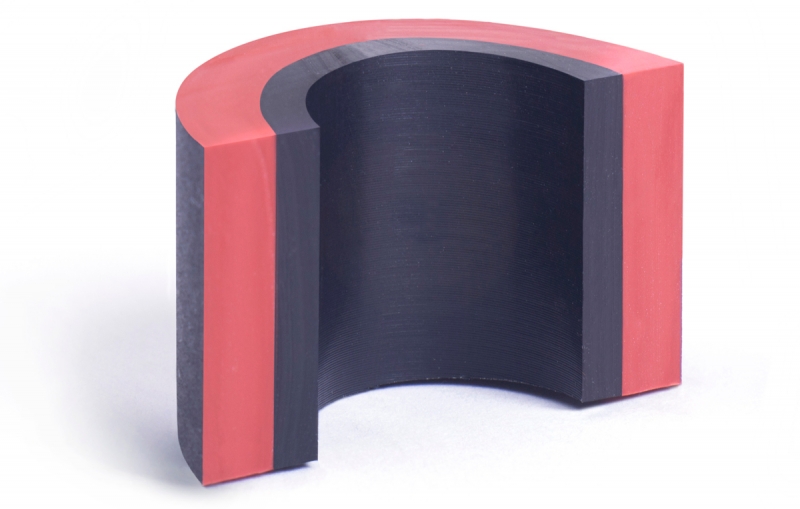
Sign-up for our newsletter dp-update
Contact us now : advice – materials – quote
Download our Free Guides
Use our handy checklist for design engineers.
Watch our videos with top tips on rubber hardness, temperature, tolerance, quality and chemical compatibility considerations
Use our Online Chemical Compatibility Database.
See for yourself
Why not take a look at a few of our press releases and case studies to see how we’ve helped companies like yours.
What our clients say
As someone who has been assessing suppliers for over 20 years it was quite apparent to me that DP Seals are technical experts and industry specialists. In meeting our 4M and QCDES standards it was their personal touch and attention to detail that helped set them apart. Natasha Witcombe Technical Procurement Engineer, Ricoh
See more testimonials
